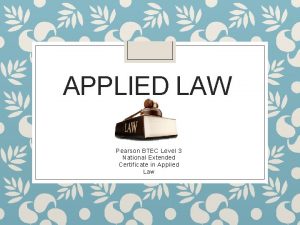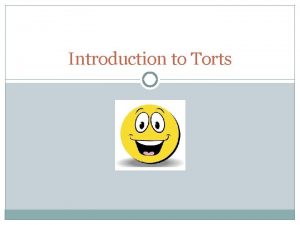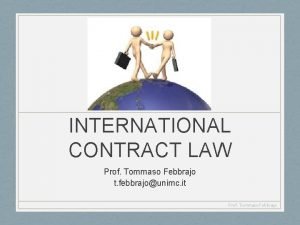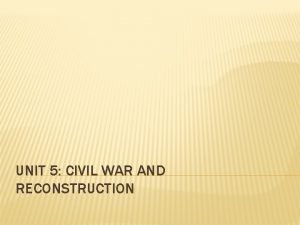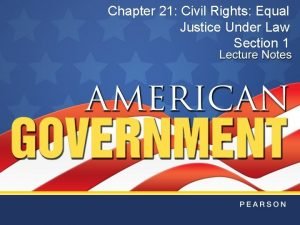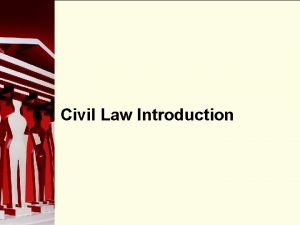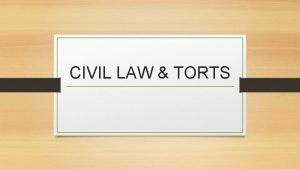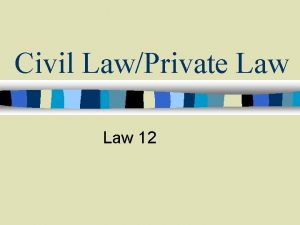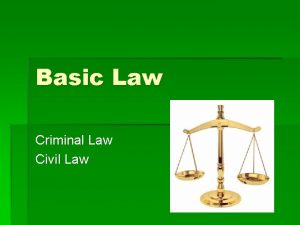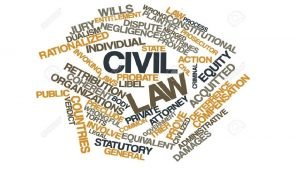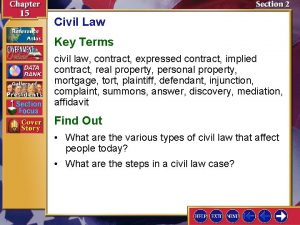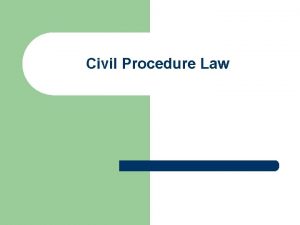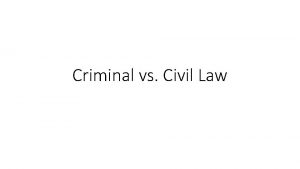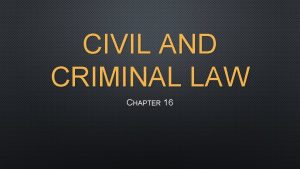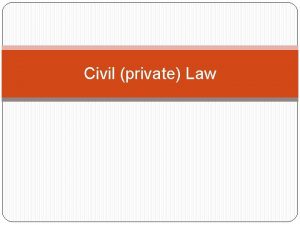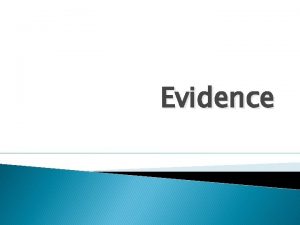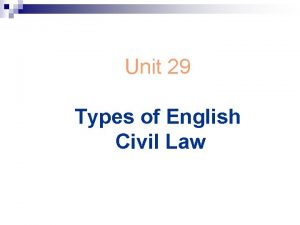Unit 3 Civil Law How is Civil Law

















- Slides: 17

Unit 3. Civil Law

How is Civil Law different that Criminal Law – Remember a private citizen brings a Civil Case called a plaintiff – The Burden of Proof in Civil Cases is “A Preponderance of Evidence” – The defendant faces economic damages not criminal penalties such as jail time.

Categories of Civil Law… Make up 80% of Cases in the U. S. – Torts – Divorce – Child Custody – Civil Rights – Wills and Estates – Negligence – Strict Liability – Slip and falls – Car accidents – Workplace accidents – Medical Malpractice – Landlord and Property disputes – Product Liability

Torts – A branch of civil law based on common law (other established court case precedents) in which a person commits or harms to a person, property or emotional well being in which the plaintiff may collect monetary damages – *Causes harm to someone or their property 3 Types of Torts – Intention Wrong: Known cause of harm or damage by defendant – Negligence : Failure to exercise reasonable care – Strict Liability: Liability even if reasonable care is taken

Liable – Essentially who should be held responsible for the harm bad what level of responsibility they have.

Torts: Fact or Fiction? Raise your hand if you think the following actually happened: 1. A woman sued a doctor for malpractice because he invited his friend to watch him deliver her baby. 2. A woman sued a railroad company because scales fell on her on a railroad platform. A railroad worker had helped a young man, who happened to be carrying a bundle of fireworks, jump onto a moving train. While jumping on the train the young man dropped his package, which caused the explosion that caused the scales to fall. 3. A woman sued a cab company when a cab without a driver hit her. The driver had jumped from the moving cab to escape a robber who had pointed a gun to the driver’s head. 4. A construction worker sued his employer for injuries sustained when he was hit by an out-ofcontrol car and thrown nearly 100 feet into a vat of boiling tar. The construction site had not been properly cordoned off.

Negligent Torts: 4 Elements – There are four basic elements of a tort: 1) Duty 2) Breach 3) Causation 4) Damages

Examples of Torts – – – – 1. Physical Injury 2. Property Damage 3. Product Liability 4. Copyright Infringement 5. Emotional Duress 6. Strict Liability 7. Defamation: Slander and Libel – Find a case for each of the following categories. Is it an Intentional Tort, Negligence or Strict Liability scenario?

Intentional Wrong: Intentionally causing harm to someone's person or property – Assault – Battery – False Imprisonment – Emotional duress – Fraud – Defamation – Trespass or Invasion of Privacy

Negligence – When a person breaches a legal obligation, or falls short of fulfilling an obligation, it is considered negligence. In some cases, a person is considered criminally negligent. For example: – A parent who leaves a two-year-old child alone in the house in order to go out to a bar and have a good time could face charges for criminal negligence. – A person who drives 40 miles over the speed limit in a really dangerous way and who causes a car accident and injures someone could be charged with criminal negligence. – A person who breaks texting-and-driving laws and who is typing a text message when he or she gets into a car accident and kills someone could be considered criminally negligent. –

Strict Liability – Strict liability, also referred to as “absolute liability, ” applies to such issues as injuries or other damages caused by a defective product, damages caused by animals, and engaging in certain hazardous activities. – A construction company using dynamite for demolition – Damages by an animal such as physical damage by a dog or property damage by livestock – Cases involving hazardous chemicals – Product Liability

Negligent Torts: Duty – Can you think of examples of due care that each of the following people must exercise? : 1. A lifeguard at a municipal pool. 2. A lumberjack felling a tree. 3. An owner of an aggressive dog. 4. A high school football coach.

Negligent Torts: Breach – Breach is the simplest of the four elements. – Once you determine the standard of care, you ask, did the defendant follow that standard of care? – For example, if the standard of care requires the owner of an aggressive dog to keep the dog on a leash and the owner does not do so s/he has breached the duty of care.

Negligent Torts: Causation in fact, also known as “but-for” causation, is pretty simple. The question is, but for the defendant’s actions would the injury have occurred? Example: A hits B in the shin with a golf club. B’s shin would not have been injured if A had not him in the shin with a golf club.

Proximate Cause Proximate cause is a little more difficult. Ultimately, it is more of a policy question than a legal question. The issue is where the law wants to cut off liability for a negligent actor. Several theories exist regarding proximate cause: 1) Foreseeability 2) Direct Causation 3) The “Danger Zone”

Defenses to Torts – 1. Comparative Negligence: The Plaintiffs actions were partially responsible for the injury or damage – 2. Counterclaim- The defense is also suing – 3. Assumption of Risk: voluntarily encountering a danger and deciding to accept the risk

Penalties for Torts – Compensatory Damages: Reward compensates for physical harm or medical bills. Or Property damages – Nominal Damages: A punishment to show the defended acted wrong even if know economic damage was done. . Could be in the amount of $1 – Punitive Damages: Damages ordered by the court to show the defendant was wrong or acted maliciously. To warn others to not act in the same manner.
 Applied law unit 3 past papers
Applied law unit 3 past papers Difference between civil law and criminal law
Difference between civil law and criminal law Difference between civil law and criminal law
Difference between civil law and criminal law Common law and civil law
Common law and civil law Common law and civil law
Common law and civil law Common law and civil law
Common law and civil law Civil rights and civil liberties webquest
Civil rights and civil liberties webquest Unit 6 review questions
Unit 6 review questions Newton's first law and second law and third law
Newton's first law and second law and third law Newton's first law and second law and third law
Newton's first law and second law and third law V=k/p
V=k/p Avogadro's law constants
Avogadro's law constants Unit 7 modern ga and civil rights
Unit 7 modern ga and civil rights Unit 4: civil war and reconstruction
Unit 4: civil war and reconstruction Unit 5 civil war and reconstruction
Unit 5 civil war and reconstruction Unit 5 civil war and reconstruction
Unit 5 civil war and reconstruction Chapter 21 civil rights equal justice under law
Chapter 21 civil rights equal justice under law 395-1453
395-1453
